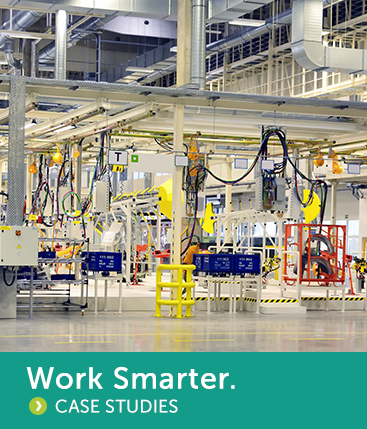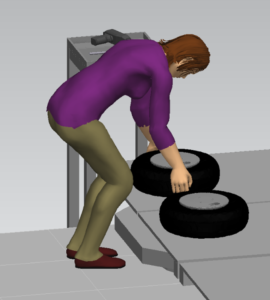Most companies are always looking for advancements in the workplace that lead to higher profits, improved quality, and a reduced cycle time. The process improvements that lead to these three items often go hand-in-hand with ergonomic improvements.
We have identified three opportunities which you may consider for possible impact at your workplace:
- Reduce Metabolic Demand
- Repeating the same process
- Reducing the frequency
To see details on how each process improvement can help, read the full article below.
—
Reducing Metabolic Demand
Walking requires metabolic expenditure of the worker. Walking is also a non value added activity (meaning that the action does not contribute to the final customer’s satisfaction or service); however, there are very few instances where it can be completely eliminated from a job. Any time the distance a worker has to walk can be reduced, it is better for the cycle time of the operation and better for the operator.
Let’s consider a single assembly worker at a small sub-assembly workstation. The distance of 14 feet does not seem very far to go from a part bin to the tool they need to operate, however, if the distance was reduced by 2 feet, it would save the operator (2ft x 2 trips per cycle x 450 working cycles in an 8 hour shift x 260 working days in a year) 468,000 feet or 88.6 miles a year. This is quite staggering when you consider that most people plan on working into their sixties.
Another example could take place at a hospital. A member of the medical staff must collect samples from an area of the hospital where patients are staying and bring them to the lab. Just think of the time gained by moving the lab closer to the collection points in addition to the reduction of metabolic demand.
Whether it is designing a single workstation or the layout of a large building, keep in mind the possibilities of reducing walk time to save both time and energy.
Repeating the Same Process
A job that is well designed and repeatable is a job that will produce the desired outcome. Most of us are familiar with the idea of fitting the work to the person—this leads to a standard process being met. If the original job was not designed to accommodate an appropriate range of the working population, some workers may find shortcuts to get the work done and these shortcuts may result in a detriment to quality.
Imagine an exterior plastic component must snap into the side panel of a car. If the force to snap it in place multiple times a day results in discomfort in some of the workers’ hands, and others have difficulty reaching the part, you may find that at the end of line, the inspectors have started writing up the exterior trim piece for poor quality.
Why? – These operators have started using the heel of their hand or a rubber mallet, for example, to “hit” the part into place. Consider a slight design change to the attachment features to reduce the insertion forces of the part or possibly reprocess the job to a different station where more workers can reach the part. At the end of the day, the worker will be happier and safer, and the quality of the end product will no longer suffer.
As you can see, a job that can be capably completed by the workforce will have the greatest chance of being performed according to process resulting in better quality.
Reducing the Frequency
Often parts and processes are over engineered in the design phase because it may be perceived that it’s better to exceed targets, such as cycle time or reliability, than to have to scramble during the product launch, trying to achieve changes in hope that the goal will be met. Once the part or process is in place and launch has tapered off, this is an excellent time to investigate reducing the frequency that may not have been caught in the design phase.
Examples of this include eliminating the number of fasteners, restaging work cells, and studying the hand tools at each station. Eliminating fasteners often requires research and design approval, quality investigations, and potentially small part changes; however, this will not only reduce the work output of the operator, but also achieve a part cost savings so it may be worth the extra work.
Restaging a work cell may sometimes help an operator to handle additional parts, thus reducing the number of trips from the fixture to the part bin. Studying hand tools is most beneficial in a large assembly operation where at a single station an operator may have two to three small hand tools. If certain elements can be reprocessed to reduce the number of hand tools by one, then that is 1 less “obtain” and “aside” that a worker has to do. If this practice is continued, your company may eventually realize a budget saving as a result of buying and maintaining fewer tools.
Of course, there are additional process improvement techniques that can aid your company, while assisting the workforce. A few good resources include:








 Why Sandalwood?
Why Sandalwood?


 We are a one-stop-shop for launching job rotation for any employer from conception to implementation. Our experts tailor our services to meet the needs of our customers by collaborating with them throughout the entire process. We do not offer cookie cutter solutions for job rotation because the needs of employers vary significantly.
We are a one-stop-shop for launching job rotation for any employer from conception to implementation. Our experts tailor our services to meet the needs of our customers by collaborating with them throughout the entire process. We do not offer cookie cutter solutions for job rotation because the needs of employers vary significantly. Why Sandalwood?
Why Sandalwood?



 Sandalwood is pleased to offer solutions above and beyond the traditional ergonomic assessments. With an in-depth knowledge of various digital human modelling software suites, integration and adoption to your health and safety programs has never been easier. Sandalwood is experienced in ergonomic program design as well as industry leaders in digital human modelling services. We have a diverse team that is able the leverage the results from the digital human model to provide in depth risk assessments of future designs and current state. Sandalwood is also able to pair these assessments with expertise and provide guidance on the best solution for you. Sandalwood is also on the forefront of emerging technologies and able to integrate Motion capture, Wearables, and extended or virtual reality into your ergonomic program.
Sandalwood is pleased to offer solutions above and beyond the traditional ergonomic assessments. With an in-depth knowledge of various digital human modelling software suites, integration and adoption to your health and safety programs has never been easier. Sandalwood is experienced in ergonomic program design as well as industry leaders in digital human modelling services. We have a diverse team that is able the leverage the results from the digital human model to provide in depth risk assessments of future designs and current state. Sandalwood is also able to pair these assessments with expertise and provide guidance on the best solution for you. Sandalwood is also on the forefront of emerging technologies and able to integrate Motion capture, Wearables, and extended or virtual reality into your ergonomic program.



